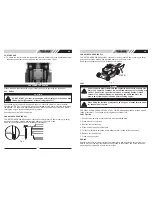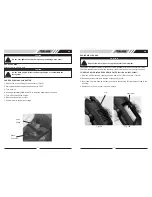
• The best time to mow your lawn is the early afternoon. By this time the grass has had a
chance to dry out. Also the sensitive newly cut grass area isn’t exposed to the direct sun.
• For healthy growth, grass should not be cut too short. Using the lowest settings can result
in destruction of the crown of grass, allowing flat lying weeds to develop.
• Vary your cutting pattern from week to week. One week mow your lawn from north to south,
the next week, mow your lawn from east to west. This will help prevent matting and
graining of the grass.
• For best performance, always keep the mower blade sharp. A blunt blade tends to tear, not
cut, the blades of grass.
• When cutting very long grass, a preliminary cut on a high setting, followed by a lower cut
(preferably a day or so later), will minimise the overall time required for the job.
• Do not try to cut too much off the grass at one time. This can cause excessive loads to be
put on the engine and also affect the mulching performance.
• It is recommended that the lowest cut height setting when mulching is #4. For best results
when mulching, cut off only the top third (or less) of the grass. Cutting lower than this will
have a detrimental effect on the mulching performance.
• When mulching, turning the mower at the end of a strip you may notice unmulched grass.
The mower deck is naturally tilted upward when turning so that the air-flow which holds the
grass in position for re-cutting is momentarily decreased. After mowing the lawn, you can
go back and mow only the turns so that the clippings are no longer visible.
• Clean the mowing chamber frequently to remove grass build-up. This will keep mowing
performance at its best, especially when mulching. Avoid cutting your lawn when it is wet.
Wet grass tends to form clumps and interferes with the mulching action of the mower.
• If you are not collecting the cut grass, mow in a pattern that deposits the clippings on the
previously cut path. So, if your mower discharges clippings on the left, the next cut should
be to the right of the previous one, and vice-versa.
• When cutting close to obstructions such as tree trunks, and when mowing to the edge of a
lawn where there is no wheel support, use the left side of the mower, giving a useful blade
‘overhang’ for ready access to awkward areas.
AU
MOWING TIPS
20




























